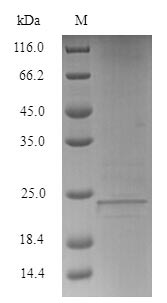Recombinant Human Lymphocyte antigen 6E (LY6E) with an N-terminal 6xHis-SUMO-tag is a full-length of mature protein expressed in E.coli. The sequence used to prepare this recombinant LY6E protein corresponds to residues Leu21-Ser101 of Human LY6E. Its purity is greater than 90% determined by SDS-PAGE. A molecular mass band of approximately 24 kDa was visualized on the gel. And in-stock LY6E proteins are offered now. This recombinant LY6E protein may be used to produce specific anti-LY6E antibodies or in the studies of cell biology.
LY6E, also called SCA2 or TSA1, is a member of the LY6/uPAR family of glycosylphosphatidylinositol-anchored proteins. It exerts roles in multiple cellular processes, such as T-cell differentiation, the regulation of the T-cell receptor signaling pathway of activated T cells, and the self-renewal of erythroid progenitors. Stephanie Pfaender etc. recently demonstrated that LY6E is a key antiviral immune effector that controls coronavirus (CoV) infection and pathogenesis through the inhibition of CoV entry into cells by interfering with spike protein-mediated membrane fusion. And LY6E is overexpressed in diverse human malignant cells.






